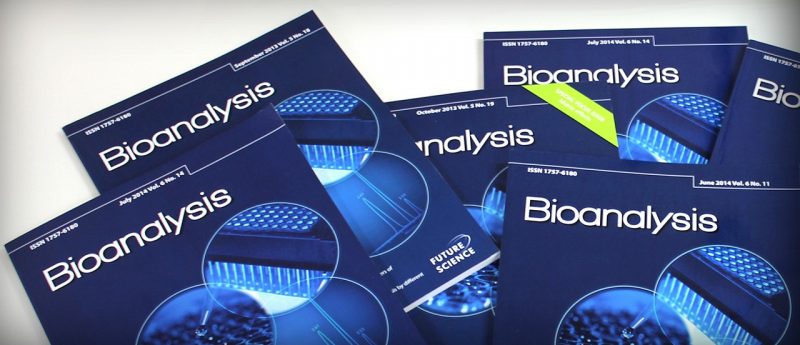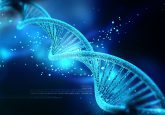Special focus issues in Bioanalysis

Volume 4 of the journal featured a number of special focus issues with high-quality contributions from eminent researchers in each of the fields. Here, we provide a snapshot of 2012’s themed issues.
Advances in chromatography
This special focus issue, published in volume 4 issue 7, investigates advances in chromatography and bioanalysis including articles on new stationary phases, column technologies and the ongoing endeavors in this specialist research area.
Of particular note are the two research articles from Kenneth Fountain and his co-workers at Waters Corporation, which provided the latest developments in hydrophilic interaction chromatography in the analysis of monoamine transmitters as well as ultra-sensitive techniques for the measurement of the steroid ethinylestradiol in human plasma.
As Associate Editor, Michael R Borenstein, comments on this issue:
“The highlight of Bioanalysis 2012, for me, was the special focus issue ‘Advances in chromatography’ published in April. The editorial and reviews were perfect examples of this journal’s unique emphasis on issues directly related to the field”.
Drug discovery
It has been well documented that the current drug-development process is long, expensive and risky, resulting in the entire R&D model of the pharmaceutical industry being questioned for its effectiveness. Guest edited by Dr Wilson Shou (Bristol-Myers Squibb), this special focus issue (volume 4, issue 9) on ‘Bioanalysis in drug discovery’ contains a selection of contributions from many well-respected experts in the field, including discussions on some unique challenges in discovery bioanalysis, reviews on current practices and perspectives for future directions.
The issue covers topics such as dried blood spot sampling in discovery toxicology studies, recent developments in software and automation tools, advances in bioanalytical sample preparation for LC–MS analysis and microsampling. In a free-to-access commentary, Tracey H Clark & Lindsay E King (Pfizer) discussed the challenges and possible solutions of discovery biotherapeutics bioanalysis. Additional authors included in this special focus issue are Patrick Bennett (Thermo Fisher Scientific), Chris A Singleton (Momenta Pharmaceuticals) and Celia J D’Arienzo (Bristol-Myers Squibb).
Commenting on the issue, Howard Hill, Senior Editor of Bioanalysis, provides his thoughts:
“The guest editor rightly states that bioanalysis ‘is an enabling technology i.e., to support many emerging and potentially paradigm changing discovery field’. Indeed the area of discovery bioanalysis has been the testing ground for the basis of many routine technologies and processes used in regulatory bioanalysis. Clark and King, in their paper summarise the issues thus: “In a discovery setting short project cycle times and limited resources can have the most impact on the bioanalytical strategy that is chosen to support a ‘biotherapeutic’ program. This pragmatism can be applied throughout the development program e.g., from the application GLP /BMV when necessary, to fit-for-purpose criteria at all times. Most, if not all, of these papers have relevance to regulated bioanalysis e.g., how much carryover is acceptable, its elimination is not always possible or cost effective. For those who are not involved in discovery analysis this special edition provides food for thought in developing and applying fit for purpose bioanalytical methodologies across the drug-development process.”
HRMS in DMPK
Guest edited by Dr Walter Korfmacher (Medpace Bioanalytical Laboratories) and Dr Ragu Ramanathan (Bristol-Myers Squibb), this special focus issue (volume 4, issue 5) on high-resolution mass spectrometry in DMPK discusses topics including discovery and development bioanalysis, with a selection of commentaries, reviews and research articles highlighting the ongoing endeavors and paradigm shift in this area.
The issue features topics including the comparison of triple quadrupole and high-resolution TOF-MS for quantification of peptides, discussions surrounding metabolomic data and in vitro ADME screening assays. HRMS will again be visited in volume 5 of the journal with a special focus issue looking at the field 1 year on, with Drs Korfmacher and Ramantha nreturning as guest editors.
Green bioanalysis
Environmental concerns are increasing and laboratories are looking for new ways to be greener. Often, streamlining laboratory processes can have cost-saving implications, generating a double incentive for improving the environmental impact of a bioanalytical laboratory. This issue (volume 4, issue 11) on green bioanalysis’ guest edited by Dr Olivier Heudi (Novartis) includes a selection of articles covering topics such as alternatives to organic solvents, means of utilizing less reagents/samples, microsampling, reduced run times, cost/energy saving laboratory strategies, streamlined processes and the use of supercritical fluids.
Anti-doping analysis and the Olympics
With the world’s attention on London for the 2012 Olympic Games, Bioanalysis published a special focus issue on anti-doping analysis and the Olympics (volume 4, issue 13). The fight against doping has always been a contentious one, where the techniques behind its bioanalytical procedures must be robust enough to stand up in both the laboratory and in court. In this special focus issue, guest edited by both Dr Olivier Rabin (World Anti-Doping Agency) and Dr Patrick Schamasch (International Olympic Committee), topics such as the history of doping analysis and the World Anti-Doping Agency, the current state of the field – including the challenges faced in implementing the Athlete Biological Passport, the use of performance-enhancing drugs such as EPO and peptides, the difficulty in maintaining a balance between regulatory bodies and laboratory approval, as well as the future of this field with respect to new technologies, testing matrices and doping agents are discussed at depth.
As Drs Rabin and Schamasch explain, “The articles contained within this special Olympic issue of Bioanalysis offers an insight into the challenges faced by the anti-doping analysts in the testing procedures of athletes’ samples, and examine some of the recent developments made in the science of anti-doping as well as some future perspectives in anti-doping testing.”
Metabolomics
The September (volume 4, issue 18) issue of Bioanalysis was dedicated to metabolomics, guest edited by Dr Andy Nicholls (GlaxoSmithKline), a co-founder of the Metabolic Profiling Forum and former member of Professor Jeremy Nicholson’s team at Imperial College London. Topics featured in the themed issue include the role of metabolomics in characterizing the human exposome, the application of the field to the study of respiratory diseases and a Special Report on addressing the current bottlenecks of metabolomics.
In his Foreword, Dr Nicholls puts into perspective the importance of the field: “To highlight what is changing is no longer an acceptable result; what must be determined is a view on the biological mechanism from the measured metabolite alterations. Addressing such challenges comes with an intrinsic dependency on open, ordered and searchable datasets, coupled with information to guide their application. Through the adoption of such a route, metabolomics could be in a position to make a larger and more significant impact to the advancement of biology; indeed to an extent comparable to that achieved through the genome.”
Comments from two Associate Editors, Marcel Musteata and David Barrett, give their thoughts on this important special focus issue, respectively:
“In 2012, Bioanalysis continued to deliver high-quality articles in eight special focus issues as well as in its regular issues. I was delighted to see that one of these issues dealt in great detail with one of the most pressing needs in the investigation of live organisms – metabolomics. Metabolic profiling is an extremely complex endeavor, requiring the separation and identification of numerous compounds with vastly different physicochemical properties. Volume 4, issue 18 of Bioanalysis rounds up leading researchers in metabolomics, delivering a full overview of the current status in this area, from insightful reviews of the current applications of metabolomics to a report addressing the current bottlenecks in the analysis of the metabolome. This issue is highly recommended to both novices and specialists in this research area.”
“This is an area relevant to both academia and industry and this was reflected in the authorship of the articles. There was excellent coverage from a number of the authors on the quality issues highly relevant in metabolomics analyses, particularly with respect to acquiring consistent results from large sample sets and the need for a quite different type of QC approach compared with traditional LC–MS/MS bioanalysis. I would expect that some of these articles would achieve good citation rates in the metabolomics and related scientific communities”.
Biomarkers
The October (volume 4, issue 20) issue of anlyzed recent developments in the field of the bioanalysis of biomarkers. Guest edited by Dr Mark Fidock (Group Director – Biomarkers & Translational Sciences, Huntingdon Life Sciences) and Dr Binodh DeSilva (Executive Director, Immunochemistry and Biomarker Development, Bristol Myers-Squibb). The issue includes a mixture of research, reviews, perspectives and editorial articles pertaining to the bioanalysis of biomarkers, including genomic and proteomic biomarkers, use of commercial biomarker test kits in drug development and regulatory expectations for the use of biomarkers.
Tissue
Bioanalysis’ issue on tissue sample bioanalysis (volume 4, issue 21) was guest edited by Dr Stacy Ho (Genzyme). The issue features a range of articles from industry and academia including Editorials, Research articles and Reviews. There is also a forward-thinking Perspective article discussing the tissue bioanalysis of biotherapeutics and drug targets to support PK/PD studies by Hendrik Neubert and colleagues at Pfizer.
As the Guest Editor explains in the Foreword to the issue: “Tissue analysis is a diverse, exciting and active subfield of bioanalysis. It is not possible to capture everything in a single issue; rather the research and review articles in this special issue offer a snapshot of the current progress and exciting developments on this topic.”





